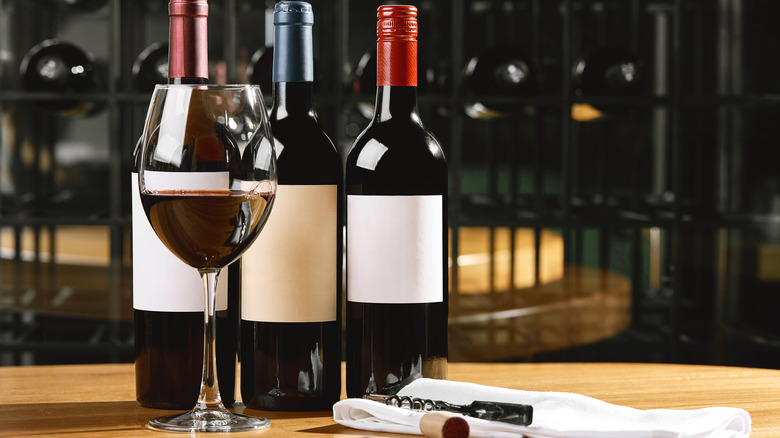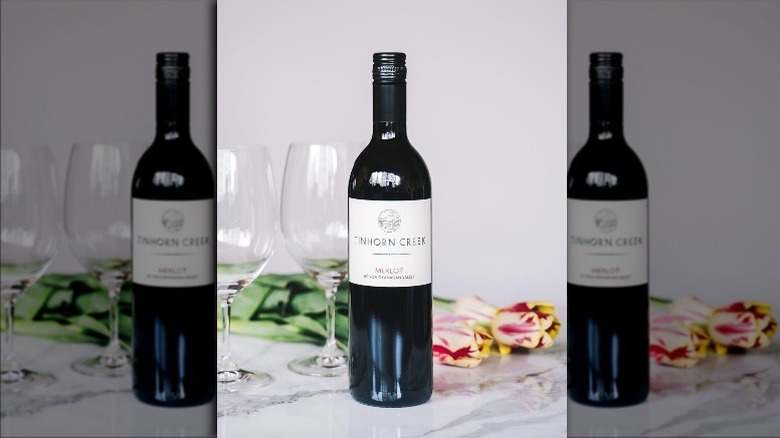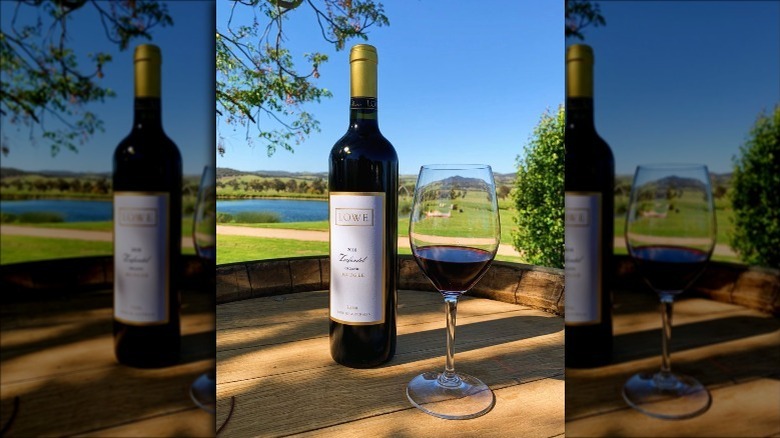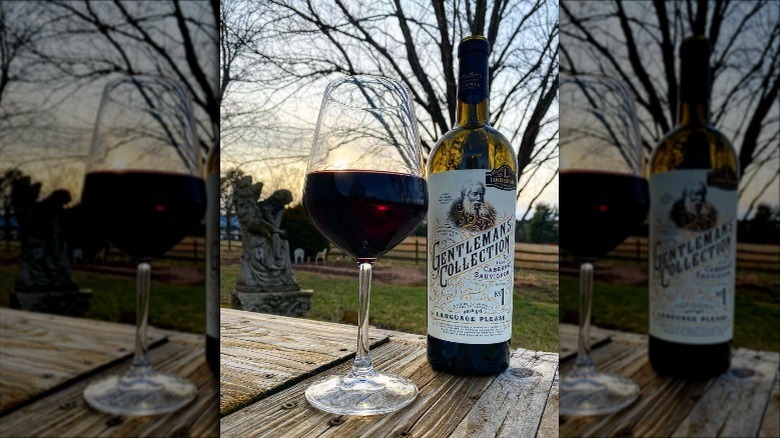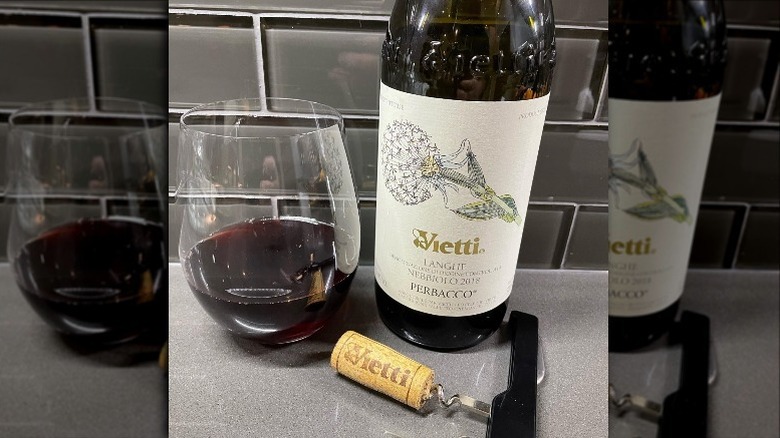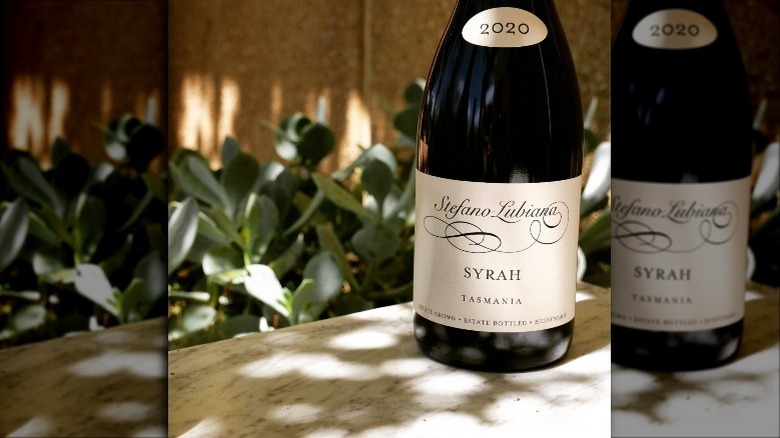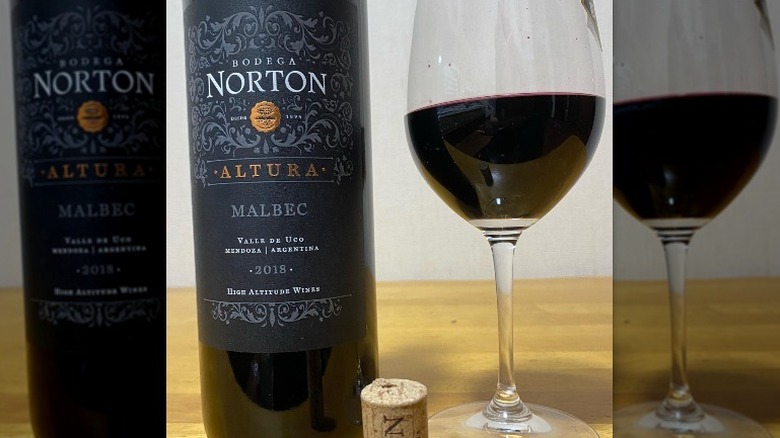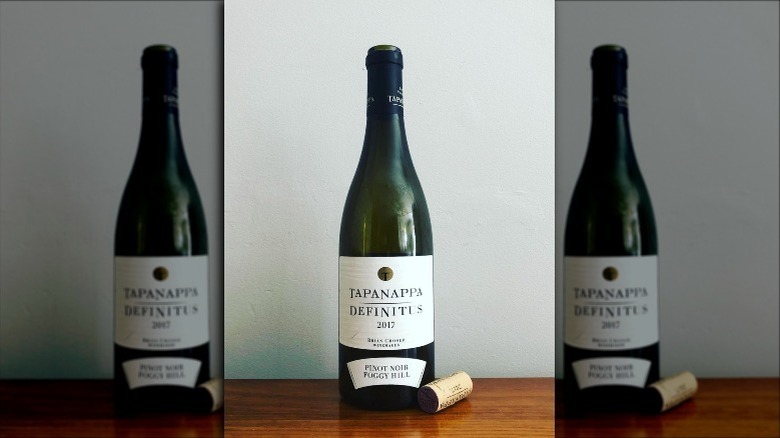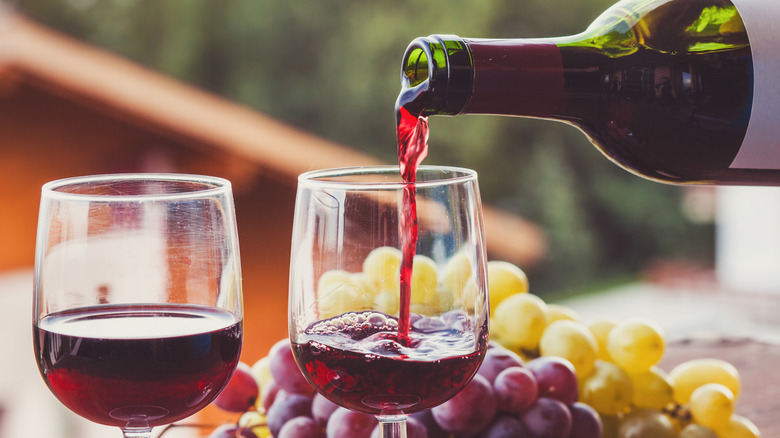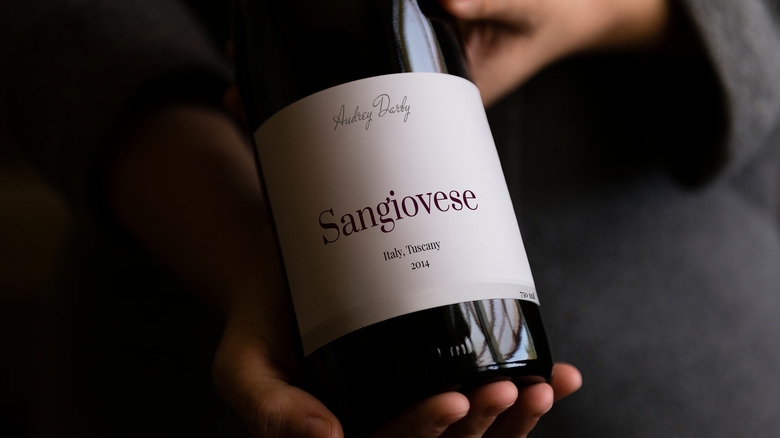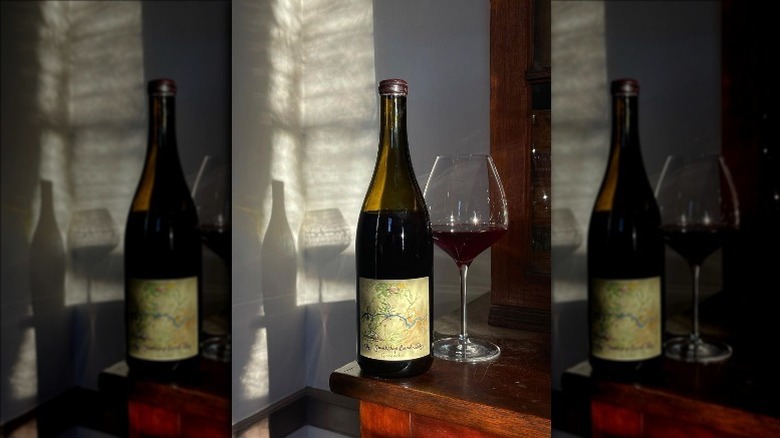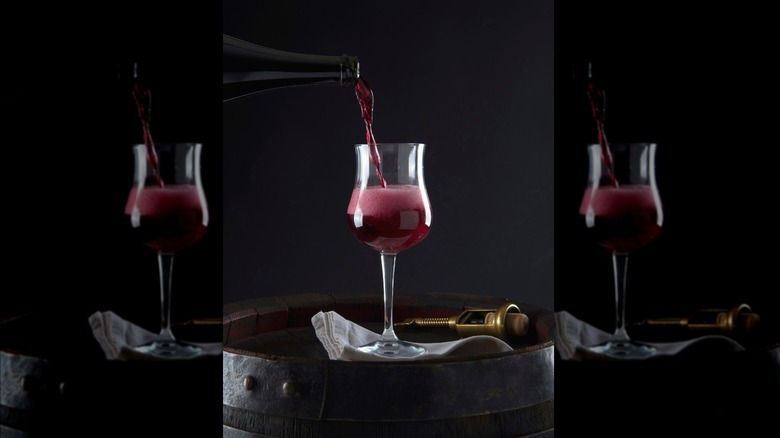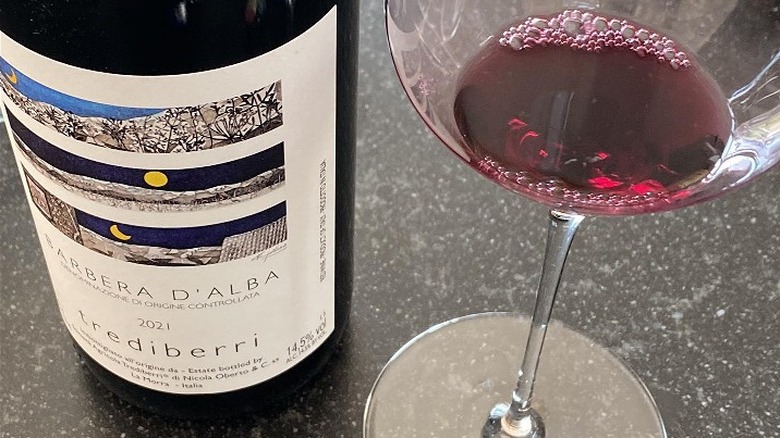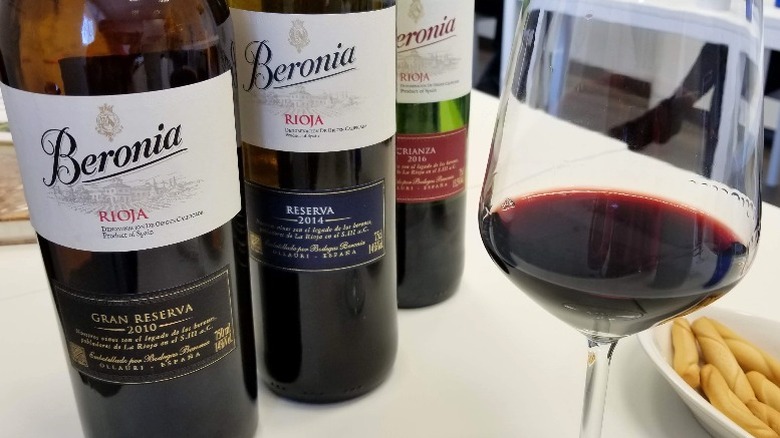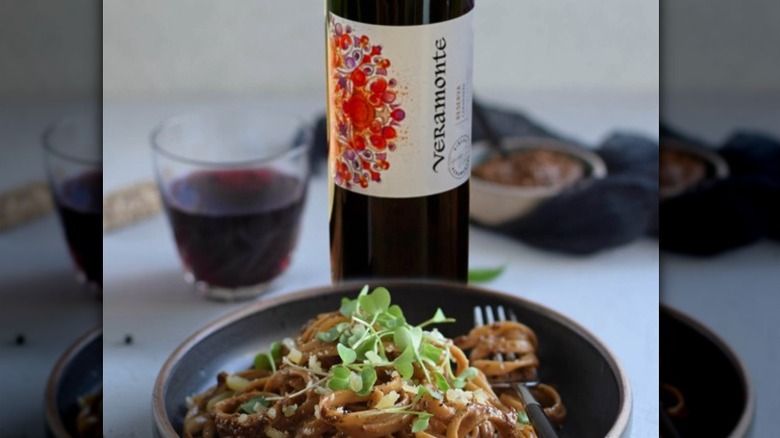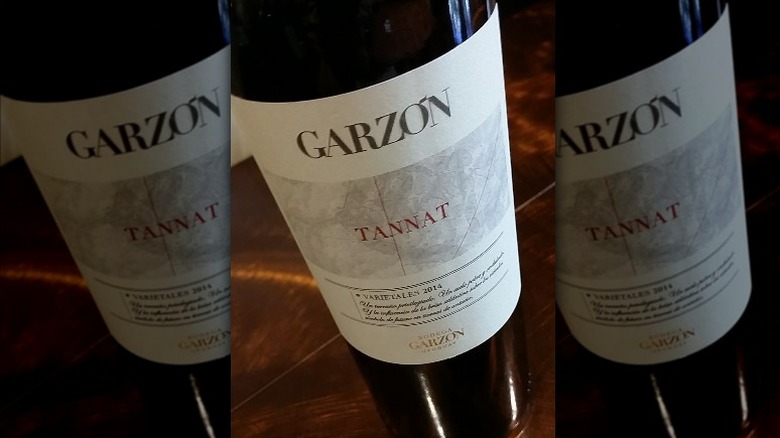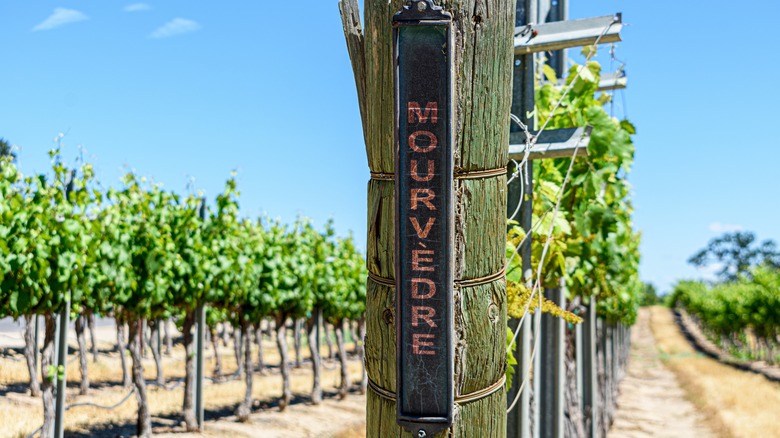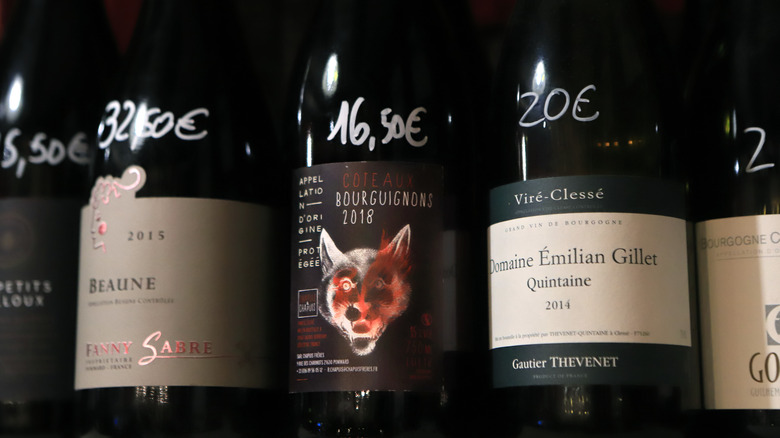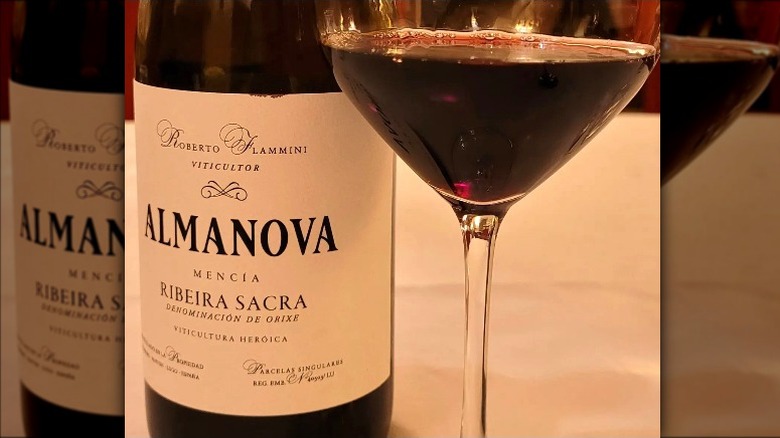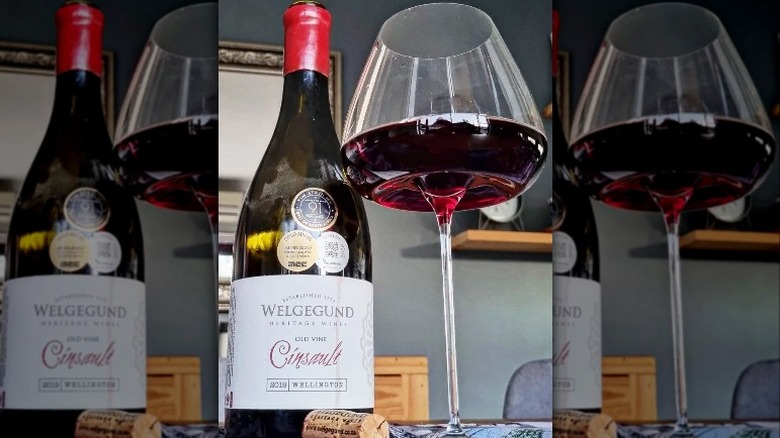Every Major Type Of Red Wine You Would Ever Need To Know
We may receive a commission on purchases made from links.
If you're a beginner in the world of red wine, walking down a wine aisle at a local wine shop or even your grocery store can be intimidating. Sure, you know that Merlot and Malbec are both red, but your knowledge doesn't go too far beyond that. If that's the case for you, don't worry. We're here to shed some light on the red wine section. The truth is, the vast majority of red wines come down to a handful of grapes, so if you know about those grapes, then you'll have a much clearer picture of the wine landscape. That can help you choose the perfect red for that steak dinner or select a bottle for your friend's housewarming party.
We're going to cover 10 common types of red wine you'll find on shelves. Of course, there are countless other varieties out there, but these are the types you're most likely to see regularly. Get acquainted with these varieties first, then make your way to your local wine shop and try them out for yourself. After all, the best way to determine what kind of wine you prefer is by sipping it yourself. Ready to get started? Here's every major type of red wine you'd ever need to know.
1. Merlot
If you're looking for an easy, approachable red wine to start sipping, you certainly can't go wrong with a Merlot. According to Wine Enthusiast, it's one of the most popular red wines in the world, and it comes in at number two in red wine popularity in the United States (right behind Cabernet Sauvignon). It's a versatile grape that can be transformed into fruity or oaky wines alike, serving a variety of taste palettes.
When you get a good Merlot, you're going to experience a well-balanced wine with moderate tannins, moderate acidity, and relatively high alcohol content. Though individual bottles may vary significantly, you can expect a medium or full-bodied wine. It's common for tasters to pick up notes of cherry, berries, or plums, or you might get a taste of chocolate or vanilla if you're drinking an oakier variety (via Wine Folly).
While a wine featuring only Merlot grapes is common on its own, these grapes also commonly find their way into Bordeaux blends. One thing's for sure: If you bring a Merlot to a dinner party, no one is going to complain. We think this is a great entry point for all those just beginning to get into wine.
2. Zinfandel
Let's clear one thing up right away: Zinfandel is not the same thing as white Zinfandel. The latter is a sweet or off-dry rosé that many wine drinkers dislike. Of course, if you like it, you should enjoy it, but you definitely shouldn't confuse it with Zinfandel, which is a red wine with moderate tannins and high alcohol levels, per Wine Folly. This results in a big-bodied wine that pairs well with various Arabic and Mediterranean cuisines. However, the wine itself is originally from Croatia, which has a thriving wine industry. Fun fact: Per Wine Folly, Zinfandel is the only grape varietal in the world that has an annual festival called the ZAP Wine Festival.
While white Zinfandel might be more common on grocery store wine shelves than red Zinfandel, you can usually find the latter without too many issues. This grape is also often found in California red blends (via VinePair). If you're looking for a bold, robust red that will pair deliciously with all of your favorite foods like grilled meats and mezze, you may find just what you're searching for in a Zinfandel.
3. Cabernet Sauvignon
Moderately bold, full-bodied, and perfect for pairing with food, it's hard not to love a good Cabernet Sauvignon. This is an extremely popular type of wine. In fact, it's the most popular in the world. Like Merlot, Cabernet Sauvignon is a great variety for beginner red-drinkers, as it's both easy to obtain and has a widely appreciated taste. You may notice notes of black cherry or black currant if you're enjoying a fruitier Cab, while an oakier variety may evoke notes of graphite or cedar, per Wine Folly. Cabernet Sauvignon is produced worldwide, from France, Italy, and Spain to South Africa, Argentina, and even China.
One of the reasons Cabernet Sauvignons are so popular is because they age really well. Tannins and chemical compounds referred to as phenolics ensure that Cabs taste amazing even after they've been in a cellar for decades (via The California Wine Club). The tannins in this wine are more pronounced in younger bottles, but older vintages tend to be more mellow, thus pairing with a wider variety of foods. If you're looking for the perfect entryway into the world of red wine, grab yourself a Cabernet Sauvignon the next time you're out.
4. Nebbiolo
According to Wine-Searcher, while Nebbiolo grapes are produced in many parts of the world, they're overwhelmingly grown in the Piedmont region of Italy. It has high-quality wines that are known for their intense tannin and acidity. Because of these qualities, they pair well with cheese and other fatty, creamy dishes, as the acidity helps cut through those intense flavors (via "Wine Folly: Magnum Edition"). Taste for notes of cherry, leather, rose, and star anise.
You may find cheaper Nebbiolo varieties on the market, but you should expect to pay around $30 for a good bottle. Due to this price point and its intense, bold flavor, Nebbiolo is generally not a wine that new drinkers start with, but it's certainly worth a try if you're looking for something new and interesting. There's a chance that you won't be able to find it in your grocery store wine aisle, but most well-stocked wine stores, especially those with robust Italian sections, should carry a wide selection of Nebbiolo. This wine can be consumed young, but it typically ages well rather quickly.
5. Syrah (Shiraz)
This one causes quite a bit of confusion for some new wine drinkers because it technically has two names. According to Wine Folly, the grape originated in France's Rhone Valley, a legendary wine-producing area. However, since then, it has made its way to Australia, and it's now the most-planted grape in the country. In Australia, they don't refer to it as Syrah like they do in Europe. Instead, it's called Shiraz. If you see different wine bottles with these different names, you'll know that they're the same grape, and it gives you an idea about where that particular bottle was produced.
This full-bodied red wine has a moderately high alcohol level, medium-high tannins, and tends to be on the drier side (though not intensely so). It's excellent when paired with dark meats and intense spices, as those flavors tend to bring out its fun, fruity side. Notes of blueberry and plum are standard, as are tobacco and milk chocolate aromas.
If you're already a fan of Cabernet Sauvignon and Merlot and want to branch out to try something new, Syrah is an excellent option. These wines share many of the same characteristics, but Syrah is a slightly less common find in the U.S.
6. Malbec
Are you looking for a way to get into South American wines? Then do we have a treat for you: it's called Malbec! Malbec is grown everywhere from South Africa to New Zealand, but most of its production comes from Argentina, per Wine Folly. VinePair says that it's been a popular blending grape in France for over 100 years, but Malbec has grown as a wine in its own right over the past few decades. And the stuff from Argentina is generally regarded as some of the best.
If you like juicy, fruity wines, Malbec is going to be perfect for you. Don't assume that juiciness means it will be too sweet, though. Most Malbec is quite dry. We love that this type of wine is affordable so that everyone can enjoy it. If you're looking for a good bottle of Malbec, you can expect to spend around $15. You should be able to find Malbec at most shops that sell wine.
While many red wines tend to have a longer finish (meaning the flavor stays with you for a while after you take a sip), the finish on Malbec is relatively short. This means it's great for pairing with red meats that tend toward the leaner side.
7. Pinot Noir
Burgundy is one of the most legendary wine regions globally, and Pinot Noir is right at home there, according to Decanter. However, it's also grown in other parts of the world, from Chile to Switzerland, so you shouldn't worry about tracking down a Burgundy if you can't find it at first. This light-bodied red is great for those who generally drink white wine but want to branch out and try something new. It's not very sweet, but the acidity is intense, making it ideal for pairing with foods that you normally wouldn't think of eating with a glass of red wine (via "Wine Folly: Magnum Edition"). Chicken, for instance, is an excellent pairing with Pinot Noir.
Unfortunately, Pinot Noir can be more expensive than other bottles, which means you'll want to spend around $30 for a bottle of the good stuff. Pinot Noir is an incredibly finicky varietal for grape growers to work with, per Wine Enthusiast, since it is susceptible to disease and root rot. But even though it is hard to grow, Pinot Noir is a fave for many drinkers, and if you haven't tried it yet, it's worth a sip.
8. Cabernet Franc
Never seen a Cabernet Franc in the flesh before? You're not alone. It's not especially common to see this wine on its own because it is most often used for blending with other varietals into Bordeaux red wines. However, it is sometimes produced as a single varietal, according to MasterClass. When you drink this wine, expect a medium-bodied red with plenty of acidity that makes it sippable and perfect to pair with tomato-based dishes. You might pick up on notes of strawberry or raspberry as well as bell pepper and chili pepper.
If you're looking for intense tannins, then Cabernet Franc is probably not for you. While it can often be confused with Cabernet Sauvignon, Sauvignon grapes have a thicker skin than Franc ones, which gives Sauvignon a heavier and more intense flavor. However, if you're not super into red wines generally, this wine is a great place to start. It's a fun option to serve at a party if you want to introduce your guests to something a little different than what they might be used to drinking.
9. Sangiovese
According to Wine Folly, Italy, Tuscany grows most of the world's Sangiovese, a dry, acidic, savory red wine. Because it's so acidic, it can pair well with spicy and other acidic dishes, making it one of our favorites for a dinner party. It pairs excellently with tomatoes and potent herbs. It can be a great option for vegetarian cooking — as long as the food you're eating has plenty of plant-derived fats. However, Sangiovese generally isn't amazing for pairing with sweet dishes, so if you're looking for a dessert-adjacent drink, it's usually not the way to go.
Wine Folly refers to Sangiovese as a "chameleon," meaning that different wines using this varietal will taste different. The variation is huge, so it pays to learn about the specific region you're getting your Sangiovese from if you're curious about the details. This fun, interesting wine is a great option for food lovers and those who want to branch out to slightly less recognized varietals that are still widely available.
10. Grenache
Grenache, also known as Garnacha in Spain, is a common grape used in wines throughout the world. VinePair describes the flavor as berry-forward with notes of strawberries and white pepper along with a hint of Fruit Roll=Ups. Umm ... sign us up! This varietal was originally cultivated in Spain, and it's sold both as a single varietal as well as appearing in blended bottles. You may want to consider pairing it with autumnal dishes like roasted veggies, lamb, or even prime rib. However, The Wine Cellar Insider shares that it's extremely versatile, so don't be afraid to try some creative pairings if that's what you're into.
While Grenache can be quite expensive, you won't have to spend a fortune to enjoy this wine to its fullest. A $15 to $20 bottle can give you a good idea of what this grape offers and initiate you into a whole new world of red wine. Give it a try the next time you cook a special dinner.
11. Lambrusco
From Italy's Emilia-Romagna, Lambrusco is a regional designation and a mix of various grapes that grow wildly and flourish quickly (via Wine Traveler). Yes, it can be confusing. Don't fret, though. You'll love this type if you like juicy, lively wine with an effervescence. With origins potentially dating back to 160 BC, Wine Folly says Lambrusco tends to be low-alcohol and easy-drinking.
The different varieties range from pale-pink to inky purple, the site says, and are produced either dry or semi-sweet. The wines also tend to have aromas of wildflower, black cherry, pomegranate, and wild herbs. Flavors can be fruit-forward like tart cranberry and sour cherry, or savory with black tea, spice, and olive. Best served chilled, this type of sparkling wine always has a bubbly element as a semi-sparkling frizzante or fully-carbonated spumante.
Regional classifications can help you determine which you'll most enjoy. Lambrusco di Modena is an uncomplicated and approachable introductory style. Lambrusco di Grasparossa is dark, dry, and structured with blue-and-black fruit flavors, bold tannins, and mouth-watering astringency. If you're a fan of semi-sweet, fruity, and creamy wines, Lambrusco Salamino and Lambrusco Reggiano should be on your list.
Lambrusco is known for high acidity that pairs with rich, fatty foods, particularly from the Emilia-Romagna province — home of balsamic vinegar of Modena, mortadella, and Parmesan-Reggiano cheese. Pair Lambrusco with parmesan risotto or a charcuterie board with Prosciutto di Parma.
12. Barbera
Slo Wine shares that over 5000 varieties of wine grapes are included in the Italian National Registry! Of which, they add about 350 are actively growing native varieties. Within Italy's northwestern Piedmont region, Barolo might be best known for its production of powerful, tannic (and often expensive) wine from nebbiolo grapes.
But, it isn't the only variety grown in this region notable for white truffles, chestnuts, and hazelnuts. The barbera wine grape thrives on low slopes and valleys below the fog line (as in, the less-than-prime locations) throughout the Piedmont province, notes Wine Folly.
Barbera wines are fleshy and food-friendly with a light-to-medium body. With its rich purple color, this wine can confuse your palate. You may expect the wine to be dense and tannic. Instead, barbera is aromatic and fresh with high acidity. The wine site shares the wine's flavors include juicy wild strawberry, tart cherry, and pencil lead. A young, fresh style of wine also has a structure, texture, and balance that is ideally enjoyed the first few years after release.
Some of the best come from vineyards around Asti and Alba, where the wines are bright and fresh with an easy approachability. Outside of Italy, barbera is grown in California, Australia, and Argentina, typically delivering darker fruit notes with higher alcohol from the warmer growing conditions.
Barbera wine is usually quite affordable, making it the perfect Tuesday night wine for pairing with regional dishes like truffle-topped chestnut agnolotti.
13. Tempranillo
Tempranillo is a tale of mediums: Medium to full-bodied, medium to low acidity, medium to high tannin, medium alcohol, and a lot of flavor. Though various red wine varieties originate in Spain, tempranillo is the country's signature grape. Foods and Wines of Spain says tempranillo grapes cover 20% of Spain's total vineyard area. The grape's native region, Rioja, enjoys high elevations with warm days and cool nights, resulting in balanced, fresh wines with notes of red fruit, soft herb, and leather. In central Spain's Ribera del Duero and Toro regions, Wine-Searcher finds the wines are more rugged, tannic, and high in alcohol due to the extreme temperatures.
Tempranillo comes from the Spanish word temprano, meaning early, because it ripens quickly, producing thick-skinned grapes on highly productive vines. The variety goes by different names, including tinto fino, cencibel, and tinta de toro, with each showing different characteristics and styles. The best tempranillo wines are from areas preserving the fruit's natural acidity.
Tempranillo has an affinity for American oak aging, embracing the oak's vanilla coconut flavors in the wine. As the wine ages, tertiary qualities emerge like dried cherry, fig, and woody herbs. By law, a Rioja Reserva wine must age at least three years, of which one year must be in barrel and six months in bottle (via Rioja Wine). Rioja delivers incredible quality for the price point. Delicious Rioja Reserva wines are available for under $20 from producers like CVNE, Beronia, and LAN.
14. Carménère
As Spain has tempranillo and Argentina has malbec, the signature red wine of Chile is carménère. Though a native Bordeaux variety, its success shines brightest in South America. After phylloxera devastated the vine in France, carménère was considered extinct. However, before the pest spread throughout Europe, vintners took cuttings of the carménère vines to Chile says Wine Enthusiast.
Vinepair adds Chilean vintners had misunderstood what variety they were growing for decades. They thought the carménère was merlot, and treated it as such in the vineyard, harvesting the fruit side by side with early-ripening grape. In the 1990s scientists confirmed they were growing a late-ripening carménère. In 1998, the Chilean Department of Agriculture designated carménère as a distinct variety, skyrocketing production. The sun-loving variety now thrives throughout Chile's Central Valley.
Carménère wines made from unripe grapes display bitter green pepper, paprika, and Tabasco. These qualities are similar to the carménère parent grape, Cabernet Franc. The wines have moderate tannin, medium to full body, rich concentration, and flavors of black plum, fig, cherry, and woody herb. Though most carménère grapes are grown in Chile, vintners in Italy and New Zealand dabble with small productions, though they too likely began growing the grape confusing it with something else.
15. Tannat
Tannat is believed to originate from the Basque country on the border of France and Spain. Today, it is most widely planted in France's Madiran region. Wine Enthusiast says tannat's opaque, purplish-black wine grapes are filled with tannin and thrive in arid, desert-like conditions, like the dry and dusty vineyards of California's Paso Robles.
Tannat is the signature variety of wine grape for Uruguay, where vintners first planted tannat vines in the 1870s. However, Uruguayan tannat is unlike other versions worldwide, in part, because cuttings came from vines from the Basque country arrived before the phylloxera louse wiped out much of Europe's vineyards throughout the 1800s (via Vinepair). Chile's old vine tannat produces wines that have bold tannin with racy acidity, dense concentration and structure, and a rustic yet finessed Old World style.
In addition to its powerful flavor profile, tannat may be one of the healthiest red wines available. The Grape Collective adds tannat has high levels of antioxidants, including polyphenols, procyanidins, flavenoids, and resveratrol, thanks to the number of seeds grown within tannat grapes; most grapes have two or three seeds, but tannat has five. If you haven't tried tannat and want to start with a good one, we love Bodega Garzon — and we're not the only ones. Bodega Garzon's Reserva Tannat has landed on Wine Enthusiast's top 100 wines of the year multiple times.
16. Mourvèdre
Deep and intense, mourvèdre is a robust, sun-loving grape that creates concentrated, full-bodied wines. The variety originates from eastern Spain, where it is known as monastrell. Cellar Tours finds that Phoenicians are believed to have introduced the grape to Spain around 500 BC before the Romans brought it to France, where it took on its internationally recognized name, mourvèdre. A challenging variety to work with, the late-ripening grape requires a long-growing cycle to fully mature, which pushes alcohol levels to extremes, often exceeding 16%, says Cellar Tours. It becomes a continuous juggling act in the vineyard as picking mourvèdre wine grapes early, before the fruit is ripe, creates intensely tannic wines with astringency.
Blending mourvèdre with other varieties, like grenache and syrah, helps create wines with balance and appealing flavors, such as the bold wines of France's Bandol. Wine Folly shares that Bandol wines are full-bodied and tannic, with peppery, meaty flavors. Wile the wine grape is integral to red blends, in Spain, mourvèdre, or monastrell, is still showcased on its own.
Mourvèdre benefits from aging to soften tannins, the wine site suggests up to ten years for the Bandol selections. Open and decant mourvèdre wine an hour or so before dinner to introduce oxygen into the wine, helping the flavors open. The meaty and robust wines pair well with hearty dishes like boneless short ribs, roasted leg of lamb, or venison.
17. Portuguese Field Blend
If you stroll through the slate-filled, steeply terraced vineyards along the Douro River in Portugal, you will see a patchwork of vines known as the Portuguese field blend. The Best Portugal explains this melange of deep red grapes creates sweet, fortified port wines, as well as dry, concentrated Portuguese red table wines. The site says the combination varies, but includes varieties like tinto roriz (the Portuguese tempranillo), touriga nacional, alicante bouchet, touriga franca, and legally upwards of 90 more. All of these are warm-weather varieties that thrive in hot, arid temperatures.
Wine-Searcher reports the effects of global warming in wine-producing regions means thick-skinned, high-tannin, and warm weather varieties that might have been obscure in the past could become the standard vines in the future. The site says varieties commonly included in the Portuguese field blend are heat resistant and adapt well to little rainfall and extreme daytime temperatures.
Although Portugal's field blend is often best associated with fortified port wines, the blends meld harmoniously as dry Portuguese table wines. Wine Enthusiast shares that in the past these wines left much to be desired; however, when Portugal joined the European Union in 1986, investment from the EU brought about essential improvements and modern technology to vineyards and wineries — white Vinho Verde has famously benefited from a modern update. Leading Portuguese winemakers, like Symington and Esporao, are crafting high-quality, affordable table wines that are powerful and have an easy-drinking, balanced style.
18. Red Meritage
Every Bordeaux wine is a blend of select varieties — including cabernet sauvignon, cabernet franc, and merlot — that must come from the celebrated Bordeaux region in France. So, how could every other international winemaker blending these varieties distinguish their wine as a premium product and differentiate itself from various other Bordeaux-style red table blends?
Enter the Meritage Alliance: The Alliance began in the United States in 1988, known then as the Meritage Association, when producers sought a way to discern their New World wine blends. The name is a blend of words: "merit" to indicate quality and "heritage," referring to the historic art of blending. With the label, premium quality blends of white and red noble varieties denoted higher prestige and the finest wines of the vintage, particularly the red blends from Napa Valley.
The Meritage Alliance is dominated by New World members mainly from California but includes international makers from Argentina, Mexico, Australia, and Canada. For red wines to be classified as a Meritage, the grape blend must contain only cabernet sauvignon, merlot, cabernet franc, malbec, petit verdot, carmenère, or the relatively obscure varieties of Saint-Macaire and Gros Verdot. Red Meritage wines can also include no more than 90% of any one variety. Enjoy red Meritage wines with dishes that pair well with Bordeaux wines, including braised lamb, pork belly, beef cheeks, or slow-cooked, sous vide ribeye.
19. Gamay
If you have ever tried a bottle of Beaujolais Nouveau wine, you have enjoyed gamay grapes. The quickly produced, grape juice-like wine is released on the third Thursday of November and raced from the Beaujolais region to Paris to celebrate the first wines of the season on Beaujolais Nouveau Day. But, gamay wines are so much more than the youthful nouveau selections.
Like pinot noir in weight and body, gamay has light tannin and high acidity, shares Vinepair. Gamay wines are also usually best served slightly chilled, highlighting the natural red fruit notes. Styles range from light and fresh to well-rounded and age-worthy. One thing is sure, all gamays are approachable, easy to drink, and delicious.
The most famous gamay wines come from Beaujolais, a 34-mile-long area in central France south of Burgundy that encompasses 12 regional designations. Vinepair says wines labeled as Beaujolais are most common, but the 10 cru Beaujolais, like Morgon, Fleurie, and Brouilly, are the most high-quality wines. If you are a fan of light-bodied wines, Wine Folly says wines from Fleurie showcase floral aromas with a delicate softness. If you prefer something heartier, the site adds the Morgon wines are similar in taste to pinot noir from Burgundy thanks to notes of dark cherry, mushroom, and truffle, especially when allowed to age.
Due to gamay's overall low alcohol, juicy fruit, and fresh acidity, the wine is incredibly food-friendly: Pair with salmon tacos, crispy roast duck, and roasted turkey and cranberry sauce on Thanksgiving.
20. Mencia
Mencía is Spain's answer to Pinot Noir. The thick-skinned up-and-coming mencía grape produces aromatic, complex wines filled with notes of wildflowers melding with dried leaves or truffles. These intoxicating aromas lead to flavors of wild strawberry and pomegranate, then finishing with spicy, freshly cracked pepper. Cellar Tours says mencía, pronounced "men-thee-ah," is a native variety to northwest Spain, specifically Bierzo in Castilla y Leon and neighboring Galicia. The delicate variety presents various challenges in the vineyard because mencía is sensitive to disease, can quickly lose acidity, and delivers high-alcohol levels, adds Cellar Tours. However, when mencía is crafted with care, the expressive wines are some of the most compelling, delicious selections from Spain today.
A region filled with mountains and valleys, Wine Tourism Mag says Bierzo benefits from its location nestled between Galicia's rainy, humid, Atlantic-influenced climate, and Castilla y Leon's sunshine-filled, continental climate. Wine Enthusiast adds that Bierzo enjoys a balanced growing season thanks to its higher, cooler elevation compared to the rest of the province, resulting in wines showcasing minerality that's attributed to the region's slate and schist deposits — a defining element of these expressive wines.
We love the wine with grilled pork belly or roasted mushroom burgers. Though the popularity of the wines has grown in recent years, mencía remains affordable, with options from Losada, Raul Perez, and Avancia often costing less than $20 — making it a good option for a red wine spritzer.
21. Cinsault
Cinsault should hold a permanent position in your wine rack if you are a fan of refreshing, balanced wines with ripe red-fruit flavors. Cinsault, also known as cinsaut or hermitage in South Africa, is a heat-loving red grape from southern France. It is a vigorous vine, producing a lot of fruit each year thanks to its resistance to drought and love of hot, dry growing conditions. But, just because the vine delivers like the "Giving Tree" doesn't mean the fruit quality is lacking: Cinsault produces clean, crunchy, bright rosé wine and luscious, dry red wines.
Cards of Wine notes cinsault is often used as a blending partner with Rhone varieties in the wines from France's Rhone Valley and Languedoc-Roussillon. It is also a key part of South Africa's regional favorite, pinotage, which is blended with pinot noir, the site adds. But, cinsault can easily shine as a single variety wine thanks to its wild red berry and stone fruit flavors. Henry Jeffreys shares in Club Oenologique that today young winemakers are producing high-quality, single-variety South African cinsault wines from old bush vines. The light-bodied wines are low alcohol, refreshing, and affordable, he adds.
Cinsault Rhone blends are perfect pairing partners for hearty, fatty dishes like Irish stew. Cinsault rosé wines are excellent with seafood and shellfish, grilled vegetables, and summer salads. Pop a bottle of single-varietal cinsault wine in the fridge for 15 minutes before opening and sip solo on a lazy summer afternoon.
